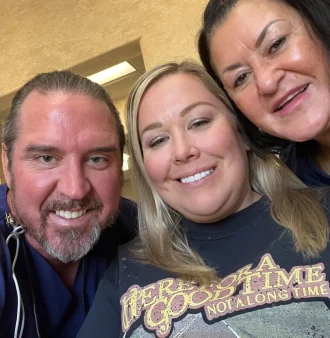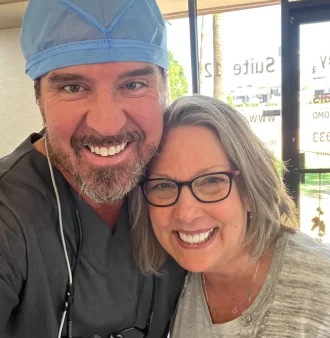Dental Bridges
The tradition fixed option for replacing missing teeth has been a fixed partial denture (FPD), more commonly referred to as a dental bridge. Dealing with the loss of a tooth can impact more than the way you look.
A missing tooth may allow your other teeth to shift and cause your bite to shift as well. This can lead to an irregular bite and put too much pressure on your remaining teeth. A missing tooth can lead to bone loss and additional dental issues down the road. There are many solutions to tooth loss, dental bridges being one of the most common.
Benefits
- Restores Smile: Bridges fill the gaps left by missing teeth, restoring the appearance of a full and healthy smile.
- Improves Chewing Ability: By replacing missing teeth, bridges allow for more efficient chewing and better digestion.
- Enhances Speech: Filling gaps can improve clarity in speech that might be impaired by missing teeth.
- Maintains Face Shape: Bridges support facial structure by preventing the collapse of facial features that can occur with tooth loss.
- Prevents Teeth Shifting: They close gaps, thereby preventing remaining teeth from drifting out of position, which could lead to further dental issues.
- Longevity and Reliability: Dental bridges are a durable and reliable restoration option with a lifespan of many years with proper care.
What people say
about Us
I've been a patient for fifteen years and I couldn't imagine going elsewhere. Everyone is professional, kind and the best of the best! I've had most every oral procedure and each has been flawless.
They are always friendly, attentive, have quick service and respond quickly to questions.
EVDP is amazing, the patient care is top notch and they do beautiful work! I felt so taken care of as patient and strongly recommend their services!
The visit was great I hope I can come up with the money some he can fix my mouth for me. At 53 have never had a kinder Dr. in my mouth. Wish I had insurance so he could do my work today.
Everyone was helpful and kind. I appreciate the introductions of who people were. My stay was pleasant and I'm hopeful my tooth problem is resolved.
What Are Dental Bridges?
Dental bridges fill the hole left by a missing tooth or teeth. This is accomplished by creating a bridge made up of a crown, then a false tooth, and then another crown.
Our dental professionals attach the crowns to healthy teeth or implants on either side of the missing tooth and fill the hole of the missing tooth with the false tooth. The most used variation is a traditional dental bridge, which is made up of porcelain, metal or ceramics or a combination of these materials.
Types of Dental Bridges
There are four types of dental bridges.
Traditional: This is the most common type of dental bridge. Traditional bridges are made up of dental crowns that are cemented onto your teeth and a fake tooth or teeth is held in place by the adjoining crowns. This type of bridge is useful when you are correcting a gap that has two healthy teeth on either side of it. The downside to a traditional bridge is that enamel will be removed from your natural teeth to install the crowns. This means that those teeth will always need to be protected with crowns.
Cantilever: A cantilever bridge resembles a traditional bridge but only utilizes one support tooth next to the gap instead of two. This type of bridge is much less popular. It typically cannot be used to fill gaps in the back of the mouth because the force of chewing may damage the bridge or neighboring teeth.
Maryland: A Maryland bridge is a nice alternative to traditional and cantilever bridges because it utilizes two small wings instead of crowns to keep the replacement tooth or teeth in place. The wings are made from a tooth colored resin and attached to the back of the adjacent teeth. This makes them nearly invisible to others. The supporting teeth are etched and the wings bonded to create a strong base for the porcelain replacement tooth.
Implant Supported: Implant supported bridges are supported by implants. This is commonly used when there are multiple teeth missing in one area. This type of bridge is the most invasive, as it requires surgery to have the implant installed. The implant is typically a small post that is attached to the bone and mimics a natural tooth’s roots. After surgery, your mouth will need time to heal. Once your mouth has healed, a permanent bridge will be installed.
Benefits of a Dental Bridge
The following are a few of the many benefits of dental bridges.
- A restored smile: Bridges can fill in the gaps caused by missing teeth so flawlessly that others will never know. This can help restore your smile and confidence.
- Prevent bone loss: Missing teeth can shift the pressure applied to your jaw when you chew and bite down. Without a replacement for those teeth, you can suffer from bone loss. Bridges can mimic your natural teeth and help prevent this from happening.
- Preserve the shape of your face: With the onset of bone loss, the shape of your face can shift. Bridges help maintain your bone and your existing facial structure.
- Keep your existing teeth in the correct position: Once a tooth is lost, the surrounding teeth may shift and move into the now open space. This can create additional issues. By installing a bridge, you effectively force your natural teeth to stay in the correct position.
- Ability to eat and chew normally: Bridges may take a little getting used to but many patients state that their ability to eat and chew improves once a bridge is in place.
- Durability: When well cared for and partnered with good hygiene, bridges last for approximately 15 years.
- Easy to maintain: Bridges do not require specialized care aside from regular flossing, brushing and visits to your dentist. Tooth decay is the primary culprit for bridge failure. The best way to combat this is to develop good oral hygiene habits. Brush your teeth at least twice a day to remove any food particles and floss daily under your natural and false tooth/teeth. Visit our dental team regularly as well.
Are Dental Bridges Right For You?
There are several important factors to consider. First and foremost, your dentist will check the health of your bone and teeth. In order for a dental bridge to be effective, the anchoring teeth, also referred to as abutment teeth, must be up for the job.
This means they must be healthy and in good condition. If there are healthy teeth or implants on either side of the missing tooth, you may be a candidate for a dental bridge. This bridge will hold a false tooth in place. This gives your false tooth the structure and support it needs to stay in place.
How Are Dental Bridges Installed?
The procedure for installing a dental bridge is fairly straightforward but will require multiple visits to the dentist. Once you and our dental professional have decided that a bridge is your best solution, you will have your first dental bridge appointment. At this time, your abutment teeth be prepared to receive the crowns and molds will be made. You will have temporary crowns put in place to protect your teeth and gums until your final bridge is ready.
Once your finalized bridge is ready, you will visit the dentist again and have your temporary crowns removed and your new, permanent bridge will be installed. This will be done in a moderate amount of time and may cause some discomfort.
While uncommon, there is a slight risk of infection. Should you experience any of the following systems, contact our dentist immediately so they can treat and monitor your condition: severe pain, swelling, redness, fever or overall feeling unwell.
Once your permanent dental bridge is in place, you may want to eat only soft foods initially while getting used to your new bridge. Once you are accustomed to it, you can resume normal eating and dental hygiene. You may even find that everyday activities such as chewing and eating are more comfortable once your dental bridge is in place.
It is important for the health of your bridge and your other teeth that you maintain strong dental hygiene habits. You should always brush your teeth at least twice a day and floss daily. A healthy diet can also support your remaining healthy teeth and gums. With proper care, your dental bridge may last anywhere from 5 to 15 years. Depending on your age, your bridge may eventually need to be replaced.
How Much Do Dental Bridges Cost?
The cost of a dental bridge can vary. Your insurance coverage, the location, and the complexities of your dental bridge will all come into play when determining the final cost of your bridge. The materials used to create your bridge may also vary, impacting the final cost. Specific pricing and totals can be obtained by contacting our dentist office.
There are many options to consider when dealing with the loss of a tooth and a dental bridge may be the best solution. However, the best course of action is to discuss your options with an experienced dental professional.
If you have lost a tooth and would like guidance on what to do next, contact our office. We listen to our patients and help them identify their goals and needs. Our team will explain all of your options and work with you to determine the best choice for your dental health.
Your Smile's Happy Place! Come visit us and see why
Fun atmosphere, friendly staff, and zero dentist nightmares


















